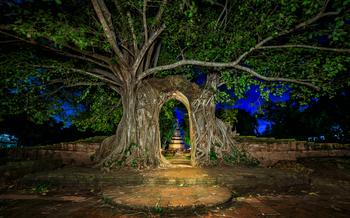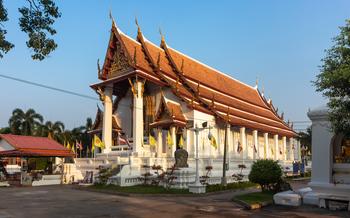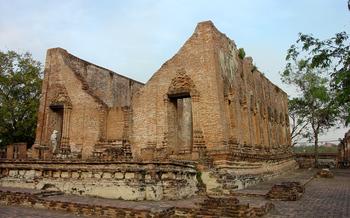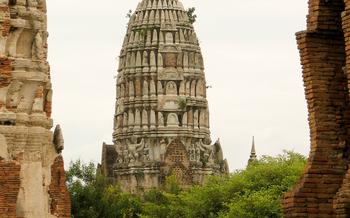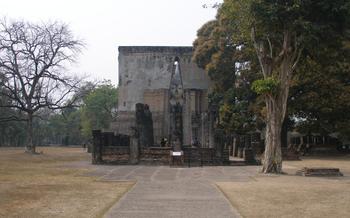
Wat Phra Ngam
- Religious Importance and Ceremonies
- Exploring the Temple Grounds
- Paying Homage to the Buddha Images
- Marveling at the Architecture
- Immerse Yourself in Religious Ceremonies
- Exploring the Surrounding Area
- Uncovering the History of Wat Phra Ngam
- Seeking Spiritual Guidance and Blessings
- Understanding Buddhist Teachings and Practices
- Capturing the Beauty of Wat Phra Ngam
- Photography Guidelines and Etiquette
- Best Spots for Capturing Stunning Images
- Tips for Capturing the Essence of the Temple
- Planning Your Visit
- Insider Tip: Hidden Gems and Secret Spots
Religious Importance and Ceremonies
Wat Phra Ngam holds profound religious significance in the Saraburi province and beyond. For centuries, it has been a revered center of worship and pilgrimage for Buddhists from all walks of life. The temple's central shrine houses a sacred Buddha image, known as Phra Si Ariyamettrai, which is believed to date back to the Ayutthaya period. Pilgrims from across the country flock to Wat Phra Ngam to pay homage to this revered image and seek blessings for their lives and families.
Throughout the year, the temple hosts a variety of religious ceremonies and festivals that draw devotees from near and far. One of the most significant events is the annual Kathin ceremony, which takes place during the Buddhist Lent period. During this time, the temple is adorned with colorful decorations and offerings, and monks gather to chant and meditate. Devotees participate in merit-making activities, offering food, robes, and other necessities to the monks in exchange for blessings.
Exploring the Temple Grounds
Layout and map of the temple complex:
Wat Phra Ngam's layout reflects traditional Thai temple design principles. A map at the entrance provides orientation, highlighting the main structures and their significance. The temple complex is divided into several zones, including the ordination hall, the Buddha image pavilion, the bell tower, and the monk's quarters. Each zone serves a specific purpose and contributes to the overall spiritual and architectural harmony of the temple.
Notable buildings and structures:
The ordination hall, or ubosot, is the central and most sacred building in the complex. It houses the main Buddha image and serves as a venue for religious ceremonies, ordinations, and other rituals. The hall's exterior showcases intricate carvings, colorful murals, and a multi-tiered roof that represents the cosmos.
Sculptures, murals, and artwork:
Wat Phra Ngam is renowned for its exquisite sculptures, murals, and artwork that adorn its buildings and grounds. These artistic masterpieces depict scenes from Buddhist mythology, the life of the Buddha, and historical events. The sculptures showcase a blend of Thai and Khmer styles, reflecting the temple's unique heritage. The murals, painted on the walls of the ordination hall, illustrate the Jataka tales, which are stories about the Buddha's previous lives.
Serene atmosphere and spiritual energy:
Stepping into the temple grounds, one can immediately sense the serene atmosphere and spiritual energy that permeates the air. The tranquility of the surroundings, coupled with the gentle sound of chanting and bells, creates a conducive environment for meditation, reflection, and spiritual connection. Visitors are encouraged to take a few moments to sit in silence, absorb the ambiance, and let the temple's energy work its magic.
Paying Homage to the Buddha Images
The heart of Wat Phra Ngam lies in its sacred Buddha images, each radiating a profound aura of spirituality and reverence. Within the ordination hall, the main Buddha image, known as Phra Phuttha Thammachot, commands attention with its serene countenance and intricate details. This magnificent statue, crafted from pure gold, exudes an otherworldly presence, inviting devotees to offer their prayers and seek blessings.
Beyond the main Buddha image, numerous other Buddha statues grace the temple grounds, each holding a unique significance. Some depict the Buddha in different stages of his life, while others represent various aspects of his teachings. Devotees often pay homage to these statues, offering flowers, incense, and candles as a symbol of their devotion and gratitude.
For those seeking spiritual guidance and blessings, Wat Phra Ngam offers ample opportunities. Monks are available to provide advice and counseling, and visitors can participate in special ceremonies and rituals to receive blessings and amulets for protection. These ceremonies, deeply rooted in Buddhist traditions, allow visitors to connect with the temple's spiritual essence and deepen their understanding of the Buddha's teachings.
Marveling at the Architecture
Wat Phra Ngam showcases a fascinating blend of Thai and Khmer architectural styles, creating a unique and visually stunning sight. The intricate carvings and decorative details on the temple's structures are a testament to the skill and artistry of ancient craftsmen. Explore the ordination hall, with its towering spire and elaborate roof decorations, and marvel at the intricate carvings depicting scenes from Buddhist mythology.
The temple's design reflects historical influences from both the Ayutthaya and Sukhothai periods, with elements of Khmer architecture adding a distinctive touch. The harmonious fusion of these styles creates a captivating visual experience that transports visitors back in time.
The symbolism and representations embedded in the architecture hold profound spiritual significance. From the lotus motifs symbolizing purity to the mythical creatures guarding the temple grounds, each element carries a deeper meaning that enriches the visitor's understanding of Buddhist beliefs and traditions.
Immerse Yourself in Religious Ceremonies
Wat Phra Ngam is a vibrant hub for religious ceremonies and events that offer a glimpse into the rich spiritual traditions of Thailand. Throughout the year, the temple hosts several festivals and special occasions that draw devotees and visitors from near and far.
One of the most significant events is the annual temple fair, which typically takes place around November or December. During this lively festival, the temple grounds are adorned with colorful decorations, and a multitude of stalls selling food, souvenirs, and traditional handicrafts line the pathways. Visitors can enjoy traditional Thai music and dance performances, as well as participate in various games and activities.
For those seeking a deeper spiritual experience, ordination ceremonies are a sacred occasion where young men formally enter the Buddhist monkhood. These ceremonies are held periodically throughout the year and involve elaborate rituals and chanting. Visitors are welcome to observe these ceremonies and gain insights into the life and traditions of Buddhist monks.
In addition, Wat Phra Ngam is known for its unique local rituals and customs during ceremonies. These may include processions, offerings of food and flowers to Buddha images, and the chanting of mantras. Visitors are encouraged to observe these customs respectfully and refrain from disrupting the ceremonies.
If you're fortunate enough to visit during a religious ceremony, remember to be respectful and mindful of the sacred nature of these events. By observing and participating in these ceremonies, you'll gain a deeper understanding of Thai culture and the profound significance of Buddhism in the lives of its people.
Exploring the Surrounding Area
Venturing beyond the temple grounds, you'll find a tapestry of attractions that beckon you to explore. Just a stone's throw away, the vibrant local markets offer an authentic Thai experience, where you can immerse yourself in the sights, sounds, and flavors of the region. Browse through stalls brimming with fresh produce, handmade crafts, and unique souvenirs, capturing the essence of Saraburi's cultural heritage.
For a culinary adventure, tantalize your taste buds with the delectable street food that lines the streets. Indulge in mouthwatering Pad Thai, savor the spicy kick of Som Tam, or relish the sweet and tangy flavors of Mango Sticky Rice. These culinary delights, prepared with fresh local ingredients and traditional recipes, will leave you craving for more.
If you seek a respite from the temple's tranquility, explore the nearby attractions that beckon with their allure. Majestic waterfalls, lush national parks, and ancient historical sites await your discovery, offering a diverse range of experiences to complement your spiritual journey at Wat Phra Ngam.
For a truly immersive experience, consider staying in one of the local guesthouses or homestays. This will allow you to connect with the warm and welcoming people of Saraburi, gaining insights into their daily lives and customs. Embrace the opportunity to learn about their unique perspectives, traditions, and the rich history that has shaped this captivating region.
Uncovering the History of Wat Phra Ngam
The origins of Wat the temple was founded over 700 years ago by a hermit named Luang Pu Thong. Guided by divine visions, he discovered a sacred Buddha image hidden in a cave on the temple grounds. This revered image, known as Phra Phuttha Mongkhon Bophit, became the centerpiece of the temple and attracted many devotees from far and wide.
Throughout its history, Wat Phra Ngam has played a significant role in the community, serving as a religious center, a place of learning, and a refuge for pilgrims. It has witnessed numerous historical events, including wars, floods, and periods of prosperity. Despite these challenges, the temple has stood resilient, preserved by the unwavering dedication of its monks and the support of the local community.
In recent years, Wat Phra Ngam has undergone extensive restoration work to preserve its architectural heritage and historical significance. The temple has been meticulously restored to its former glory, showcasing the exquisite craftsmanship and intricate details that make it a true masterpiece of Thai architecture.
Seeking Spiritual Guidance and Blessings
At Wat Phra Ngam, visitors have the opportunity to seek spiritual guidance and blessings from the resident monks. These monks are highly respected and knowledgeable individuals who have dedicated their lives to the study and practice of Buddhism. They are available to provide guidance on meditation, mindfulness, and ethical conduct, as well as to answer questions about Buddhist teachings and practices. Visitors can also receive blessings from the monks, which are believed to bring protection, good luck, and spiritual growth. To show respect, it is customary to make a small donation to the temple when receiving a blessing.
Understanding Buddhist Teachings and Practices
Wat Phra Ngam offers a profound opportunity to delve into the core principles of Buddhism and explore their practical applications in daily life. At the heart of Buddhist teachings lies the concept of the Four Noble Truths, which illuminate the nature of suffering, its causes, its cessation, and the path to its end. Through meditation techniques and mindfulness practices, visitors can cultivate inner peace, clarity, and compassion.
The temple's serene atmosphere provides an ideal setting for self-reflection and contemplation, inviting visitors to explore their own thoughts, emotions, and actions. Ethical conduct and moral teachings are emphasized, encouraging individuals to lead virtuous lives based on principles of non-violence, honesty, and generosity. The concept of karma and reincarnation, central to Buddhist beliefs, encourages individuals to take responsibility for their actions and strive for positive outcomes in this life and beyond.
Capturing the Beauty of Wat Phra Ngam
Photography Guidelines and Etiquette
Respecting the Sanctity of the Temple Grounds
- Photography is generally permitted within the temple grounds, but it is essential to be mindful of the sacred nature of the site.
- Avoid using flash photography, as it can be disruptive to other visitors and may damage the artwork and artifacts.
- Refrain from taking photos of monks or other people without their permission.
- Be cautious about taking photos near religious ceremonies or rituals, as these moments should be respected.
Best Spots for Capturing Stunning Images
- The main Buddha image in the ordination hall is a popular subject for photography, offering a majestic and awe-inspiring sight.
- The intricate carvings and decorative details on the temple's exterior provide excellent opportunities for capturing the beauty of Thai architecture.
- The surrounding gardens and courtyards offer serene and picturesque settings for photography, allowing visitors to capture the temple's natural beauty.
Tips for Capturing the Essence of the Temple
- To truly capture the essence of Wat Phra Ngam, try to visit during the early morning or late afternoon when the light is soft and golden, creating a magical atmosphere.
- Experiment with different angles and perspectives to find unique and captivating compositions.
- Pay attention to the details, such as the intricate carvings, murals, and sculptures, which add depth and character to your photographs.
Planning Your Visit
Ideal Time to Visit for the Best Experience:
To fully appreciate the beauty and serenity of Wat Phra Ngam, plan your visit during the dry season, which typically runs from November to April. During this time, the weather is pleasant, with clear skies and minimal rainfall, making it ideal for exploring the temple grounds and taking stunning photographs.
Dress Code and Appropriate Attire:
When visiting Wat Phra Ngam, it is essential to dress respectfully, as it is a sacred religious site. Avoid wearing revealing or overly casual clothing. Opt for lightweight, modest attire that covers your shoulders and knees. Visitors should also remove their shoes before entering the temple buildings.
Respectful Behavior and Conduct:
As a visitor to Wat Phra Ngam, it is important to be mindful of your behavior and actions. Maintain silence and refrain from loud talking or disruptive activities. Show reverence towards the Buddha images and other sacred objects within the temple. Please remember that this is an active place of worship, and visitors should be respectful of the monks and other devotees.
Accessibility and Facilities for Visitors:
Wat Phra Ngam is generally accessible to visitors, with well-maintained pathways and steps leading to the temple buildings. However, it is important to note that some areas may require climbing stairs or navigating uneven surfaces. The temple also provides restrooms and drinking water for the convenience of visitors.
Insider Tip: Hidden Gems and Secret Spots
Beyond the main temple grounds, Wat Phra Ngam conceals several hidden gems that offer unique experiences for the discerning traveler. Explore the serene meditation gardens tucked away in secluded corners, where you can find tranquility and connect with your inner self. Discover the ancient stupas and chedis scattered throughout the temple complex, each with its own captivating story to tell. Keep an eye out for the intricate carvings and sculptures adorning the temple walls, revealing tales from Buddhist mythology and history. Uncover the secret passageways leading to hidden chambers and chambers, where you can glimpse the temple's rich past. Embrace the opportunity to uncover these hidden treasures, creating a truly memorable and enriching experience at Wat Phra Ngam.


